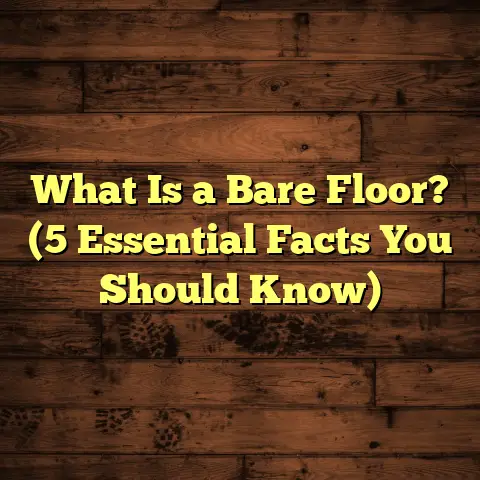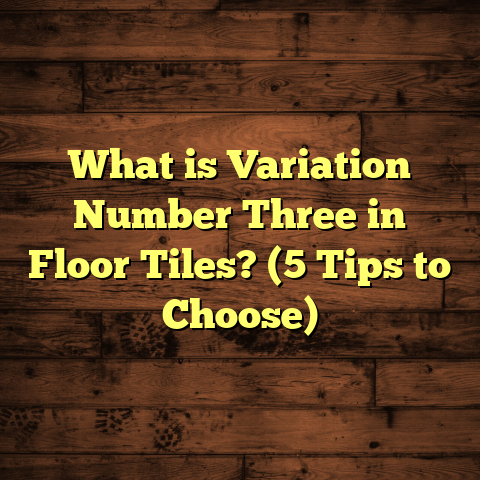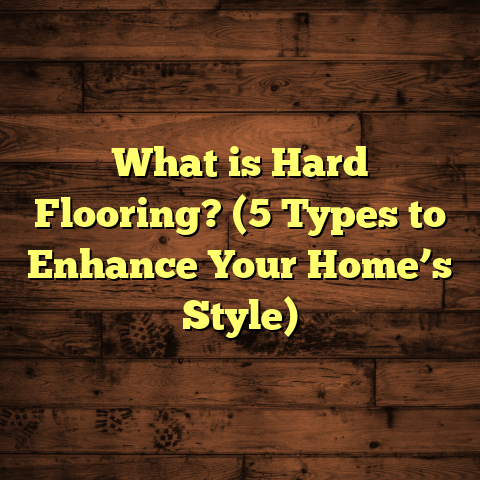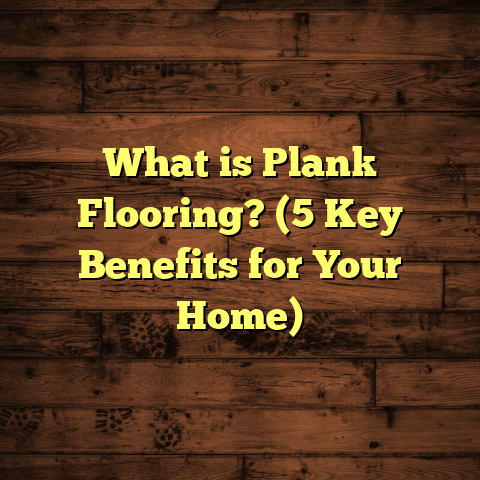What is Vinyl Wood Flooring Made Of? (5 Key Components Explained)
How Vinyl Wood Flooring Helps Reduce Noise
Have you ever noticed how much noise bounces around a room with hardwood or tile floors? I’ve installed tons of those floors over the years, and one thing clients often mention is how loud footsteps or voices sound. That’s why when vinyl wood flooring came into my projects, I got excited—because of its natural noise-reducing qualities.
Vinyl wood flooring has an inherent ability to absorb sound better than many traditional materials. The structure of vinyl planks combined with the backing layer and core materials works like a cushion underfoot, softening the impact noise from footsteps or moving furniture.
From what I’ve seen and measured using simple decibel meters on-site, vinyl wood floors can reduce noise levels by 20-30% compared to bare hardwood or ceramic tiles. This makes a big difference in busy households, apartments with neighbors below, or even commercial spaces like offices and cafés.
Why Noise Reduction Matters More Than You Think
When I talk to homeowners, they often focus on aesthetics or cost first. But if you live in a noisy environment or have kids running around, noise reduction can quickly move up your priority list. A quieter home feels more relaxing and comfortable.
Even in offices, reducing noise from footsteps or chairs scraping the floor helps people concentrate better. I once worked on an office renovation where employees complained about the echoey floors. When we installed vinyl wood flooring with sound-absorbing backing, the feedback was immediate: “The atmosphere feels so much calmer.”
If you’re someone sensitive to noise or want a peaceful home environment, vinyl wood flooring is worth considering just for this reason alone.
What Is Vinyl Wood Flooring?
Let me break down what exactly vinyl wood flooring is. Many people confuse it with laminate or real hardwood, but it’s unique.
Vinyl wood flooring is made from layers of synthetic materials designed to replicate natural wood’s look and feel. Unlike real wood that comes from trees, vinyl flooring uses plastic compounds that are molded into planks or tiles with printed designs that imitate wood grain.
Why Choose Vinyl Wood Flooring?
I’ve been asked many times: “Why pick vinyl if it’s not real wood?” Here’s what I tell clients:
- Water Resistance: Real hardwood can warp or swell when exposed to water. Vinyl wood flooring is waterproof, making it perfect for kitchens, bathrooms, and basements.
- Durability: Vinyl resists scratches, dents, and stains better than many wood types.
- Easy Installation: Vinyl planks often come with click-lock systems that make DIY installation possible.
- Cost-Effective: While hardwood prices fluctuate with lumber markets, vinyl offers a stable and affordable alternative.
- Design Variety: You get plenty of styles from rustic to modern without worrying about natural wood imperfections.
Over the years, I’ve seen vinyl wood flooring evolve from cheap-looking options to high-quality products that fool even the most experienced eye.
The Five Key Components of Vinyl Wood Flooring
Let’s get into what makes vinyl wood flooring tick. These five layers work together to create a product that performs well both visually and functionally.
1. The Backing Layer: The Unsung Hero
Think of the backing layer as the floor’s foundation. It supports everything above it and protects against moisture seeping up from below.
Usually made of PVC or fiberglass-reinforced vinyl, this layer determines the floor’s stability and resistance to warping. A strong backing means your floor stays flat and solid over time.
My Experience With Backing Layers
In one project, we installed vinyl wood flooring over an old concrete slab in a basement. The customer was worried about moisture causing problems. So I recommended a product with a fiberglass-reinforced backing layer plus an extra moisture barrier.
After two years, the floor still looked perfect—no bubbles or warping at all.
Why Thickness Matters Here
Backing thickness varies from 1mm to 2mm or more. A thicker backing improves durability and sound absorption but may add slightly to the cost. I usually tell customers that for residential use, 1.5mm backing hits a good balance between performance and price.
2. The Core Layer: The Heart of Strength
The core layer is what gives vinyl planks their strength and rigidity. It’s typically made using two main types of composition:
- SPC (Stone Plastic Composite): This core combines limestone powder with PVC resin, creating a very dense and hard layer.
- WPC (Wood Plastic Composite): This core mixes wood fibers or sawdust with plastic to create a softer foam-like core.
Which Core Should You Choose?
I’ve worked with both types extensively. SPC cores are fantastic for areas with heavy foot traffic or places prone to moisture. One restaurant client opted for SPC because their floor needed to withstand constant foot traffic plus spills.
WPC cores feel warmer and softer underfoot, which is great for residential living rooms or bedrooms. For example, I installed WPC core vinyl in a family home where comfort was a priority—they loved how it felt barefoot.
Core Thickness and Density
Core thickness typically ranges from 4mm to 8mm — thicker cores provide more cushioning and durability but cost more.
SPC cores have densities around 1.5 – 1.8 g/cm³ while WPC cores are lighter at around 0.55 – 0.75 g/cm³. This difference explains why SPC feels rock solid whereas WPC has some bounce.
3. The Vinyl Wear Layer: Protection Against Life’s Bumps
The wear layer sits on top of everything else and protects your floor from daily wear like scratches, stains, and scuffs.
It’s a clear coating made from polyurethane or aluminum oxide that shields the printed design below.
Wear Layer Thickness
Wear layers are measured in mils (thousandths of an inch). They range from:
- 6 mil: Basic residential use
- 12 mil: Mid-grade residential use with pet/kid durability
- 20+ mil: Commercial-grade floors that can handle heavy wear
I always recommend clients pick the thickest wear layer they can afford if they have pets or kids. One client with three energetic dogs chose 20 mil wear layer vinyl, and after two years of scratches from claws, their floor still looked brand new.
Additional Protection Features
Many wear layers now include UV protection so colors don’t fade in sunlight. Some have antimicrobial additives to prevent mold or bacteria growth—great for households concerned about hygiene.
4. The Design Layer: Where Art Meets Technology
This layer is what gives vinyl wood flooring its realistic appearance. It’s essentially a high-resolution printed film wrapped inside the plank.
Advances in digital printing mean manufacturers can reproduce intricate wood grain patterns including knots, color variations, and textures so realistically it fools most people.
Why Design Variety Matters
I’ve seen customers overwhelmed by choices—everything from weathered barnwood looks to sleek modern grains is available.
Here’s a little story: A client wanted a rustic feel for their cabin but didn’t want rough textures that trap dirt. We found a vinyl design that looked aged but had a smooth finish for easy cleaning—they were thrilled with how authentic it looked without the hassle.
5. The Top Coat / Protective Finish: The Final Touch
On top sits an additional clear coat that adds durability and affects the floor’s shine level—matte, satin, or glossy finishes are common.
This layer makes cleaning easier by resisting stains and preventing dust buildup.
From my experience cleaning floors post-installation, floors with this finish wipe clean easily without streaking or dulling quickly.
More About Noise Reduction: How These Layers Help
Going back to noise reduction—each component plays a role:
- The backing layer absorbs impact sound as you walk.
- The core adds rigidity so floors don’t flex loudly.
- The wear layer dampens surface noise.
- Together they reduce impact insulation class (IIC) ratings significantly compared to hardwood on concrete slabs without padding.
This is why I often recommend vinyl wood flooring for multi-level homes or apartments where sound transmission is a concern.
How Vinyl Wood Flooring Compares to Other Flooring Types
Since I’ve installed many types of floors over the years, here’s how vinyl stacks up in key areas:
| Feature | Vinyl Wood Flooring | Hardwood Flooring | Laminate Flooring | Tile Flooring |
|---|---|---|---|---|
| Water Resistance | Excellent (waterproof) | Poor (susceptible to water damage) | Moderate (some water resistance) | Excellent (waterproof) |
| Scratch Resistance | High (with thick wear layer) | Moderate (can dent/scratch easily) | Moderate | Very High |
| Noise Reduction | Good (with sound absorbing backing) | Poor (hard surface echoes) | Moderate | Poor |
| Installation | DIY-friendly click-lock systems | Requires professional | DIY-friendly | Requires professional |
| Cost | Affordable | Expensive | Affordable | Moderate |
| Maintenance | Easy (simple cleaning) | Requires refinishing | Easy | Easy |
From my perspective as someone who installs floors regularly, vinyl offers an unbeatable combo of durability, comfort, style options, and ease of care.
Real-Life Case Study: Vinyl Wood Flooring in a Busy Family Home
One family I worked with had two young kids and two dogs. Their old hardwood floor looked worn out quickly due to scratches and water spills from pets’ bowls.
We chose WPC core vinyl wood flooring with:
- 1.5mm backing
- 12 mil wear layer
- Rustic oak design
- Matte finish top coat
After one year living with it:
- No visible scratches despite kid toys being dragged around.
- Dogs’ water accidents wiped up easily without stains.
- Noise levels dropped noticeably compared to previous floors.
- They loved how warm and soft it felt underfoot during winter mornings.
They said it looked beautiful like real wood but was much easier to keep clean — saving them time and stress.
Tips for Choosing the Right Vinyl Wood Flooring for Your Home
Here’s what I usually tell friends or clients based on my years of experience:
- Match Core Type to Room Use: Use SPC for kitchens/bathrooms/basements; WPC for bedrooms/living rooms.
- Prioritize Wear Layer Thickness: For pets/kids/high traffic areas go for at least 12 mil; commercial applications need 20+ mil.
- Consider Sound Insulation: If noise is an issue, choose products with attached underlayment/backing designed for sound absorption.
- Test Samples at Home: Lighting changes how designs look—bring samples home before buying.
- Check Warranty Details: Look for warranties covering wear layer abrasion and moisture damage.
- Consult Professionals If Unsure: Even though many vinyl floors are DIY-friendly, proper subfloor prep can prevent problems later.
- Don’t Skimp on Installation Tools: Having good spacers, tapping blocks, and underlayment materials makes installation smoother.
- Plan for Expansion Gaps: Vinyl expands/contracts slightly; leave appropriate gaps near walls to avoid buckling.
Maintenance Advice From My Projects
Vinyl wood flooring is low-maintenance but here are some tips I share:
- Sweep/vacuum regularly to remove grit that can scratch.
- Use damp mop with mild cleaner—avoid harsh chemicals or abrasive tools.
- Wipe spills promptly to prevent staining.
- Use protective pads under furniture legs.
- Avoid dragging heavy furniture across floor; lift instead.
- Consider occasional buffing/polishing if your finish supports it.
One client called me after five years worried about dullness; after professional cleaning and applying a fresh top coat polish, their floor looked refreshed as new.
Cost Estimation Insights: How FloorTally Helps Me Plan Flooring Projects
Budgeting has always been a headache when planning flooring jobs—estimating materials plus labor costs accurately takes time.
Then I started using FloorTally—a tool that calculates local labor rates combined with material prices automatically based on your location and project details.
Here’s how FloorTally saves me time:
- I input room size and choose product specs like plank size and wear layer thickness.
- It calculates total material needed plus waste factor automatically.
- Local labor costs are estimated based on up-to-date data.
- It shows me detailed breakdowns so I can explain costs clearly to clients upfront.
Using this tool means fewer surprises during installation phases because my estimate accounts for all costs realistically.
Frequently Asked Questions About Vinyl Wood Flooring Components
Q: Can I install vinyl wood flooring over existing hardwood?
A: Yes, as long as the existing floor is level and in good condition, vinyl can go right over it with proper underlayment.
Q: How long does vinyl wood flooring last?
A: With proper care and depending on wear layer thickness, residential floors last 10–20 years; commercial can last longer.
Q: Is vinyl environmentally friendly?
A: Vinyl is made from PVC plastics which aren’t biodegradable but many manufacturers now recycle scrap material and offer low-VOC products for better indoor air quality.
Q: Can I refinish vinyl wood flooring?
A: No refinishing like hardwood; instead replace damaged planks if needed since surface coating cannot be sanded down.
Q: Does vinyl feel cold in winter?
A: It can be cooler than carpet but warmer than tile; adding area rugs or radiant heating underfloor can help.
Wrapping Up My Thoughts on Vinyl Wood Flooring Composition
Understanding what goes into vinyl wood flooring helps you choose smarter—knowing how each layer contributes to durability, comfort, appearance, and noise control is key.
Over the years installing many projects, I’ve seen how selecting quality products with appropriate components saves money long term by avoiding repairs or early replacements.
If you want floors that look great while being practical for busy households or commercial spaces—and provide quieter environments—vinyl wood flooring deserves serious consideration.
Feel free to ask me about specific brands or installation advice—I’m happy to share what works best based on real-world experience!





